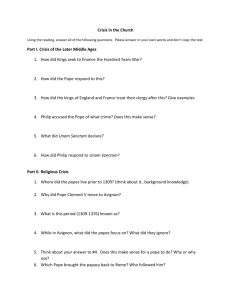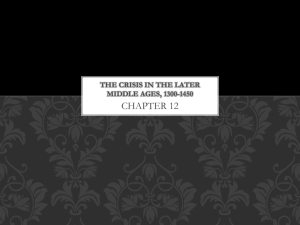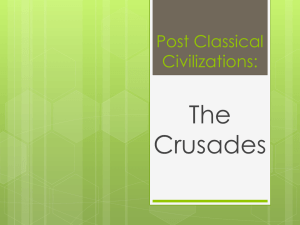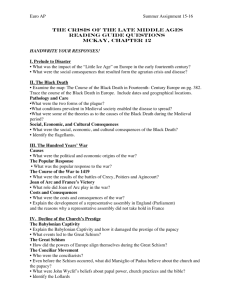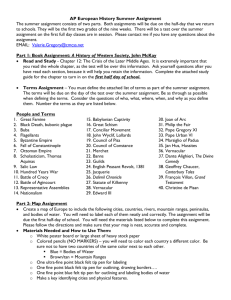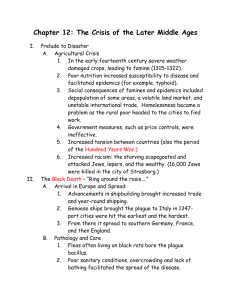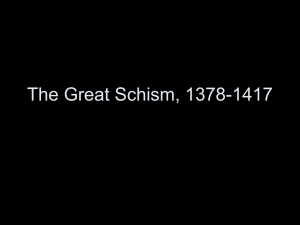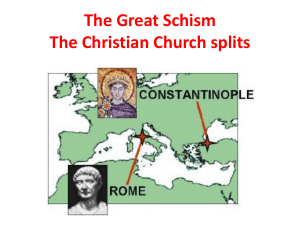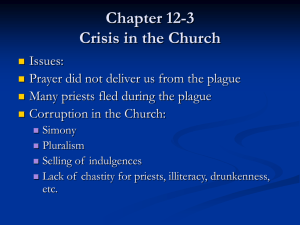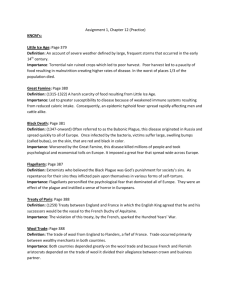Chapter 12
advertisement
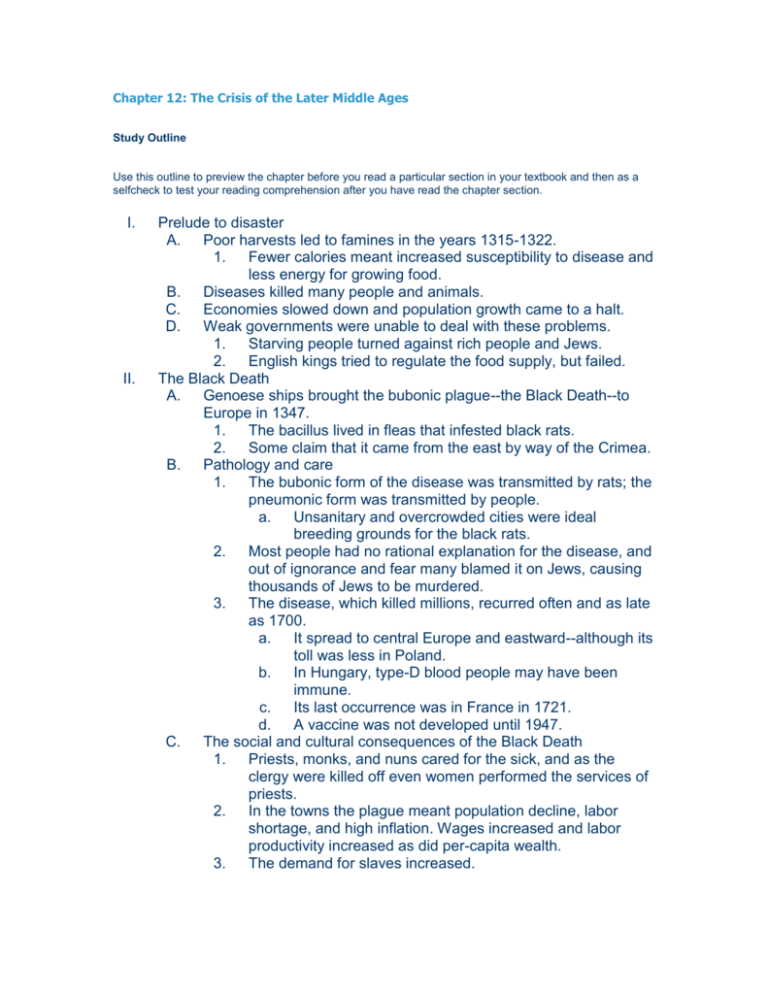
Chapter 12: The Crisis of the Later Middle Ages Study Outline Use this outline to preview the chapter before you read a particular section in your textbook and then as a selfcheck to test your reading comprehension after you have read the chapter section. I. II. Prelude to disaster A. Poor harvests led to famines in the years 1315-1322. 1. Fewer calories meant increased susceptibility to disease and less energy for growing food. B. Diseases killed many people and animals. C. Economies slowed down and population growth came to a halt. D. Weak governments were unable to deal with these problems. 1. Starving people turned against rich people and Jews. 2. English kings tried to regulate the food supply, but failed. The Black Death A. Genoese ships brought the bubonic plague--the Black Death--to Europe in 1347. 1. The bacillus lived in fleas that infested black rats. 2. Some claim that it came from the east by way of the Crimea. B. Pathology and care 1. The bubonic form of the disease was transmitted by rats; the pneumonic form was transmitted by people. a. Unsanitary and overcrowded cities were ideal breeding grounds for the black rats. 2. Most people had no rational explanation for the disease, and out of ignorance and fear many blamed it on Jews, causing thousands of Jews to be murdered. 3. The disease, which killed millions, recurred often and as late as 1700. a. It spread to central Europe and eastward--although its toll was less in Poland. b. In Hungary, type-D blood people may have been immune. c. Its last occurrence was in France in 1721. d. A vaccine was not developed until 1947. C. The social and cultural consequences of the Black Death 1. Priests, monks, and nuns cared for the sick, and as the clergy were killed off even women performed the services of priests. 2. In the towns the plague meant population decline, labor shortage, and high inflation. Wages increased and labor productivity increased as did per-capita wealth. 3. The demand for slaves increased. 4. III. The psychological consequences of the plague were enormous: pessimism, gross sensuality, religious fervor, and flagellantism. a. Society became divided and full of fear. b. Artists and writers became obsessed with death. The Hundred Years' War (ca. 1337-1453) A. The causes of the war 1. Edward III of England, the grandson of the French king Philip the Fair, claimed the French crown by seizing the duchy of Aquitaine in 1337. 2. French barons backed Edward's claim as a way to thwart the centralizing goals of their king. 3. Flemish wool merchants supported the English claim to the crown. 4. Both the French and the English saw military adventure as an excuse to avoid domestic problems. B. The popular response to the war 1. Royal propaganda for war and plunder was strong on both sides. 2. The war meant opportunity for economic or social mobility for poor knights, criminals, and great nobles. C. The decline of medieval chivalry 1. Chivalry, a code of conduct for the knightly class, enjoyed its final days of glory during the war. 2. Chivalry and feudal society glorified war. D. The course of the war to 1419 1. The battles took place in France and the Low Countries. 2. At the Battle of Crécy (1346), the English disregarded the chivalric code and used new military tactics: the longbow and the cannon. 3. The English won major battles at Poitiers (1356) and Agincourt (1415) and had advanced to Paris by 1419. E. Joan of Arc and France's victory 1. Joan of Arc participated in the lifting of the British siege of Orléans in 1429. 2. She was turned over to the English and burned as a heretic in 1431. F. Costs and consequences 1. The war meant economic and population decline for both France and England. 2. Taxes on wool to finance the war caused a slump in the English wool trade. 3. In England, returning soldiers caused social problems. 4. The war encouraged the growth of parliamentary government, particularly in England. a. IV. V. The "Commons" (knights and burgesses) acquired the right to approve all taxes and developed its own organization. b. In France, neither the king nor the provincial assemblies wanted a national assembly. 5. The war generated feelings of nationalism in England and France. The decline of the church's prestige A. The Babylonian Captivity (1309-1377) 1. The pope had lived at Avignon since the reign of King Philip the Fair of France and thus was subject to French control. a. The Babylonian Captivity badly damaged papal prestige. b. It left Rome povertystricken. 2. Pope Gregory XI brought the papacy back to Rome in 1377, but then Urban VI alienated the church hierarchy in his zeal to reform the church. 3. A new pope, Clement VII, was elected, and the two popes both claimed to be legitimate. B. The Great Schism (1378-1417) 1. England and Germany recognized Pope Urban VI, while France and others recognized the antipope, Clement VII. 2. The schism brought the church into disrepute and wakened the religious faith of many. C. The conciliar movement 1. Conciliarists believed that church authority rested in councils representing the people--not the authority of the pope. 2. Marsiglio of Padua had claimed in 1324, in Defensor Pacis, that authority within the church should rest with a church council and not the pope and that the church was subordinate to the state. 3. John Wyclif attacked papal authority and called for even more radical reform of the church. a. He believed that Christians should read the Bible for themselves, prompting the first English translation of the Bible. b. His followers, called Lollards, disseminated his ideas widely. 4. Wyclif's ideas were spread to Bohemia by John Hus. 5. An attempt in 1409 to depose both popes and select another led to a threefold schism. 6. Finally, the council at Constance (1414-1418) ended the schism with the election of Pope Martin V. The life of the people in the fourteenth and fifteenth centuries A. Marriage and the family 1. B. C. D. Marriage usually came at 16 to 18 years for women and later for men. 2. Legalized prostitution existed in urban areas and was the source of wealth for some women. 3. Economic factors, rather than romantic love, usually governed the decision to marry. 4. Divorce did not exist. 5. Many people did not observe church regulations and married without a church ceremony. Life in the parish 1. The land and the parish were the centers of life. 2. Opportunities to join guilds declined in the fourteenth century. a. Strikes and riots became frequent. b. Women were increasingly excluded from guilds. 3. Cruel sports, such as bullbaiting and bearbaiting, and drunkenness reflected the violence and frustrations of the age. a. The execution of William Wallace illustrated the violence in society. 4. Because of the crisis within the church, lay people increasingly took over church management from the clergy. Furcollar crime 1. Furcollar crime was crime committed by nobility--a phenomenon on the increase in the fourteenth and fifteenth centuries. a. In England, nobles returning from war had little to do and were in need of income; thus they resorted to crime. b. Kidnapping, extortion, and terrorism by the upper classes were widespread. 2. Because governments were not able to stop abuses, outlaws such as Robin Hood sought to protect the people. a. The popularity of the Robin Hood legends symbolized the deep resentment of aristocratic corruption and abuse. Peasant revolts 1. Major peasant revolts against the nobility occurred in France in 1358 (the Jacquerie), 1363-1484, 1380, and 1420, and in England in 1381. a. French peasants were angry about taxes, food shortages, fur-collar crime, and other circumstances. b. One cause of the Revolt of 1381 was the lords' attempt to freeze wages. c. In general, peasants were better off; the revolts were due to rising expectations. d. VI. VII. The 1381 revolt in England was due to economic grievances, anti-aristocratic sentiment, and protest against taxes. e. King Richard II and his nobles tricked the peasants into ending the revolt. 2. Workers in Italy (the ciompi), Germany, and Spain also revolted. Race and ethnicity on the frontiers A. Earlier (twelfth and thirteenth century) migrations led to peoples of different ethnic-racial background living side by side. 1. "Race" meant language, custom, and law--not biological anthropological classification. 2. In the early period, newcomers were given separate but equal rights (legal pluralism). a. The great exception to this was Ireland, where the English practiced extreme racial discrimination. b. The Irish had no access to law courts and were considered unfree. 3. In the later Middle Ages legal pluralism disappeared and emphasis on legal homogeneity, language, and blood descent led to ethnic tension. a. Language differences between clergy and people led to tension in Poland, Ireland, and elsewhere. b. The arrival of new monastic groups led to conflicts between language groups. c. Towns were dominated by immigrants while the countryside was dominated by natives. d. Famine and the Black Death led to ghettoization and racial savagery. e. Intermarriage was often forbidden and discriminatory laws were applied to certain language groups. 4. This discrimination had its basis in the effort of privileged groups to protect their economic interests. Vernacular literature A. The emergence of national consciousness is seen in the rise of literature written in national languages--the vernacular. B. Many literary masterpieces manifest this new national pride. 1. Dante's Divine Comedy, a symbolic pilgrimage through Hell, Purgatory, and Paradise to God, embodied the psychological tensions of the age and contains bitter criticism of some church authorities. 2. Chaucer, in the Canterbury Tales, depicted the materialistic, worldly interests of a variety of English people in the fourteenth century. 3. Villon used the language of the lower classes to portray the reality, beauty, and hardships of life here on earth. 4. 5. 6. Christine de Pisan's poems and books on love, religion, and morality celebrated the historical accomplishments of women and provided advice for all women. Vernacular literature emerged in eastern Europe, partly as a result of new national self-consciousness. Overall, the number of laypersons who could read and write increased but society continued to be based on oral culture.
